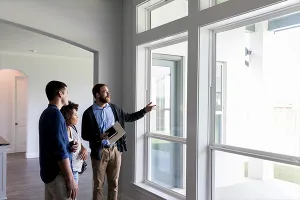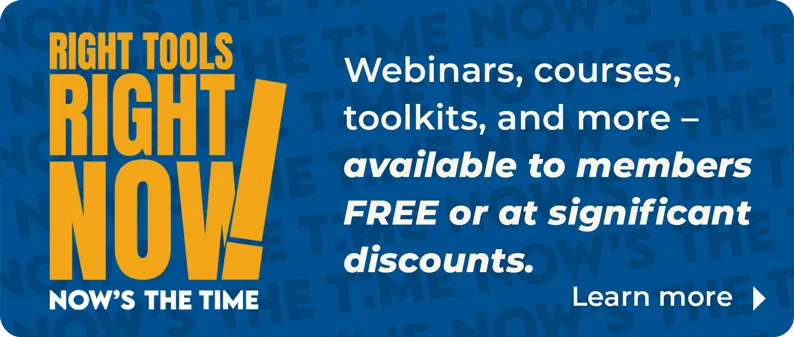Hybrid meetings are here to stay. REALTOR® association members want convenience and safety, and virtual options deliver. And while a budget-minded approach is possible, the REALTORS® of today and tomorrow expect relevant, high-quality experiences that can’t be done on the cheap, say association executives who are pioneering delivery of hybrid meetings.
It’s part of an association’s value proposition, says Aspire North REALTORS® CEO Kimberly Pontius. “Members need training,” he says. “They need continuing education credits. They need to be exposed to what’s going on in the world around them [when] they’re too busy to raise their heads up and do a 360-degree scan. If they need all that and need it quickly, and they want it done in a way that makes it interesting, [hybrid] is the direction we are moving.”

Avoiding Missteps
When Howard County Association of REALTORS® first went hybrid with board and committee meetings, the solution was a laptop in the middle of the room. “The first time we sat down in a meeting and had that laptop sitting on the table and nobody could hear each other or see each other, we knew it was time to do something significant,” says HCAR Director of Operations Sarah Rayne.
The association responded by investing in a Logitech Rally Plus videoconferencing kit for the boardroom—a suite of AV tech including cameras, microphones, and monitors. “We respect everyone’s level of comfort,” says Rayne. “If a member wants to participate and volunteer and give us their valuable input, we do not want them to be unable to do so because they don’t feel comfortable coming into the office and attending in-person meetings. We need to make it easy for our members to participate in a hybrid option.”
Members affirmed their trust in Florida REALTORS® by registering in record numbers for the 2020 convention, held online—and offered for free. Even as in-person events started to return, some members remained leery, so in 2021 the association expanded its hybrid options to meet members wherever they felt comfortable. “Members needed a knowledgeable source, and they knew we were here,” says CEO Margy Grant. “We got that engagement and took it to another level.”
Production quality has to be at the place where someone is willing to stop during the day and tune in.”
— Margy Grant, CEO, Florida REALTORS®
In Michigan, Pontius led a multiyear rebranding project that culminated in the installation of hybrid capabilities in 2019. The system offers more than convenient virtual attendance, Pontius says—it allows the association to avoid the influence of brand-blurring middlemen and reinforces the Aspire North brand with custom backdrops. “We control our narrative with our production capabilities,” he says. “It’s not somebody else telling our story.”
For Pontius, a basic tech wish list for office use would include an iPhone 13 Pro for its cinema-quality video, a sturdy tripod, a quality microphone, and a ring light for up-close illumination. That’s about $2,500, he says, but AEs should consider budgeting twice as much to allow add-ons such as a gimballed video stabilizer and post production editing tools.
“Invest in a really good backdrop with your logo and skip the green screen for now,” Pontius adds. “Then find a kid who can show you how to use the tech, or toss them a few bucks and they may do it for you.”
An Imperative for Quality
Today’s digitally savvy consumers know amateur content when they see it. At Florida REALTORS®, Grant strove to deliver high production values that would meet members’ strict quality expectations—and members responded by flocking to online sessions. “Production quality has to be at the place where someone is willing to stop during the day and tune in,” she says. “Members are telling me, ‘This is what we want, this is what we are interested in, and we will show up.’”
Florida REALTORS® uses its corporate Zoom account for hybrid purposes, skipping more pricey online meeting platforms such as Meeting Play and Freeman, which the association used in the past for a membership conference and governance meetings, respectively. The association’s director of meeting planning learned to operate the account for meetings and presentations mostly through trial and error, but eventually was able to free up speakers and meeting chairs to concentrate on their primary duties.
The flow and structure of hybrid meetings must be preplanned, Grant advises. At one recent hybrid meeting held in a hotel ballroom, cameras were positioned around the room, and monitors were staged every six feet. When virtual attendees spoke, a standard Zoom setting allowed each to appear solo on the screens, “so you’re not looking at the Brady Bunch,” says Grant.
“We rehearsed, made adjustments, and rehearsed again,” she adds. “Zoom does an incredible job of [making] information available for the users. Our communications and video team did the same thing with [Zoom’s] video options and live-streaming. Preparation and planning are crucial, as is making sure you have the appropriate internet capacity for your event—especially if it’s being done off-site.”
Aspire North outfitted three conference rooms with flexible meeting and production capabilities. Mounted pan-tilt cameras track speakers automatically, and the association’s audio setup is just as whiz-bang as its video. “So many times, people go to Sam’s or Best Buy to get a couple of speakers, wire them up, and think that’s good,” Pontius says. “It’s not. You need dynamic sound systems that can adjust to the speakers, and you need automated, multipoint video systems so you don’t have to have a technician in the room all the time.”
High-quality production values are essential for the “in the room” feeling that keeps virtual participants engaged and contributing, rather than just logging in while they juggle other tasks, says Rayne.
“You can’t control everything, but we can be intentional about making sure we are doing things that make it as easy as possible for virtual participants to be engaged, such as by making sure they can hear us, making sure they can see us, ensuring that they have all the materials they need, including them in any votes, and making sure the chair asks if anyone on the call has any input,” she says.
Watching the Budget
For 2022 and 2023, Grant has earmarked the funds necessary to go fully hybrid with Florida REALTORS®’ two largest meetings, especially for high-level information and entertainment sessions. However, she says she has learned that people don’t always “see a monetary value in an online meeting.” That lesson was apparent when the decision to remove a fee from one online meeting sent registrations skyrocketing from six people to 1,500.
In the hybridized atmosphere, however, formerly inactive members are tuning in. “The people coming online didn’t come before,” Grant says. “They didn’t necessarily see the value in coming to Orlando for a convention. But if they have a chance to log on and hear the general counsel speak or the public policy director speak, they’ll do that.”
For hybrid events, Florida REALTORS® strikes a balance between paid in-person attendees and non-paying virtual participants by offering a limited slate of online sessions—perhaps six selected sessions out of 18 presented. Whether free online access will continue for high-end events is a bridge to cross once pandemic conditions have eased, Grant says.
The video-consuming general public has been conditioned to expect free access to virtual meetings and events, Pontius says. For continuing education, they skip fee courses and look for free classes “unless they have a desire to really learn something and see a value in it,” he says. Still, members “expect to hear from you. They expect you to provide them with something way beyond the newsletter.” For time-strapped REALTORS®, he suggests short videos offering messages about trending topics or upcoming events.
To help finance the installation and ongoing operation of high-end audiovisual equipment and software, Pontius recommends pulling money away from the “sacred cows” of associations—holiday parties, golf outings, little-used services—that can no longer justify their costs.
HCAR made its AV system a budget priority, folding it into the planning process instead of borrowing or reallocating funds from other line items. Like Florida REALTORS®, HCAR uses Zoom for hybrid meetings, which keeps costs down while also delivering a familiar experience.
“I want this to be easy,” says Rayne. “I don’t want a complicated system that is going to be outdated in a couple of years. I just want high-quality audiovisual equipment that makes it easy for us to walk in, turn on our computers, start the meeting, and get ready to roll.
“Associations should work with a professional AV company to determine what equipment will best suit their needs,” she adds. “Pricing can fluctuate greatly depending on your needs, how much equipment you need, the quality of the equipment and how many spaces you need to equip. Get an assessment from an AV company in consultation with IT, and go from there. Tell them you’d like several price options. Then figure out which will fit your budget.”
Reaping the Benefits
Hybridized meetings and events are expanding the circle of involvement in associations. At HCAR, even active volunteers appreciate the ability to attend meetings without leaving their offices and homes, Rayne says: “It’s not all about COVID-19.”
As engagement soars at Florida REALTORS®, so do donations to the association’s political action committee, which are now at an all-time high. Hybridizing meetings is “100%” serving the mission of the association and its members, Grant says.
As long as the pandemic continues, associations must accommodate members who feel uncomfortable attending in-person events, Rayne says—and in the coming months and years, the availability of hybrid events will help spark continued engagement.
“I’ve heard a lot of people say it is so nice to log onto Zoom and participate wherever they are,” she says. “It’s more convenient for them. They have experienced this option that makes it easier for them to participate in the association, in addition to being a little safer.”









